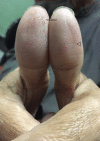Adermatoglyphia: Barriers to Biometric Identification and the Need for a Standardized Alternative
- PMID: 31011502
- PMCID: PMC6456356
- DOI: 10.7759/cureus.4040
Adermatoglyphia: Barriers to Biometric Identification and the Need for a Standardized Alternative
Abstract
Arguably, fingerprinting is the single most widely utilized method for individual identification and authentication (I&A). Dermatoglyphics form a vital portion of mass data collection, biometric scrutiny, and verification. Adermatoglyphia, or simply, loss of fingerprints attributed to a medical cause, represents a taxing situation for such biometric scrutiny systems requiring a fingerprint scan as a mandatory phase in I&A procedure. The scenario can be extremely debilitating for the adermatoglyphia patients, especially when the condition is permanent or irreversible. This article reviews different causes of adermatoglyphia, the challenge it poses to biometric identification, and the potential substitute modalities for fingerprinting technology. These modalities can function as a backup program for biometric surveillance in both medical and non-medical settings under circumstances when the fingerprinting method fails to comply.
Keywords: adermatoglyphia; biometrics; finger printing; identification and authentication; loss of fingerprints.
Conflict of interest statement
The authors have declared that no competing interests exist.
Figures



References
-
- Galton F. New York: Macmillan & Co; 1892. Fingerprints.
-
- Palmar and planter epidermal configuration (dermatoglyphics) in European, Americans. Cummins H, Midlo C. Am J Phy Anthropol. 1926;9:471–502.
-
- Dermatoglyphics: in health and disease - a review. Bhat GM, Mukhdoomi MA, Shah BA, Ittoo MS. Int J Res Med Sci. 2014;2:31–37.
-
- Plateaux A, Lacharme P, Rosenberger C, Jøsang A. CD-ARES 2014. Lecture Notes in Computer Science. Vol. 8708. Springer; 2014. One-Time Biometrics for Online Banking and Electronic Payment Authentication. Availability, Reliability, and Security in Information Systems; pp. 179–193.
-
- A novel cause of economic loss due to hand dermatitis. Ramam M, Krishna SG. Arch Dermatol. 2011;147:753. - PubMed
Publication types
LinkOut - more resources
Full Text Sources
